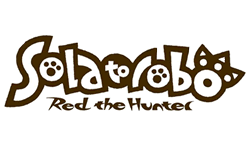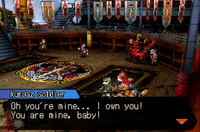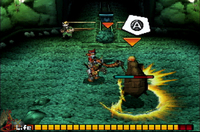|
|

|
PLATFORM
|
DS
|
BATTLE SYSTEM
|

|
INTERACTION
|

|
ORIGINALITY
|

|
STORY
|

|
MUSIC & SOUND
|

|
VISUALS
|

|
CHALLENGE
|
Easy
|
COMPLETION TIME
|
Less than 20 Hours
|
|
OVERALL

|
+ Quick & entertaining combat
+ Widely-varied action stays interesting
+ Involving cast & tale
- Flying isn't fun
- Could've gone on longer
+ Side quests worth experiencing
|
Click here for scoring definitions
|
|
|
In the twilight of its life, the DS hasn't seen many RPGs cross the Pacific. There are a number of reasons for this, but all of them boil down to a poor likelihood that games needing plenty of localization effort will sell enough to justify the cost. Solatorobo: Red the Hunter is thus very important to XSEED Games, since breaking the retail curse that afflicts the DS is not a task lightly assumed. Whether Solatorobo can succeed on the sales chart is impossible to answer until the time comes, but if the game's quality is any indication, it should find a home in every action RPG lover's DS.
The game's full title reveals that its protagonist is Red, a Hunter who flits between the airborne islands that make up the world in search of treasure and fun. His adoptive sister Chocolat handles the piloting of his ship for transit between islands, and the pair has a grand time until a new character is added to their dynamic. This person is Elh, and it turns out she's been trying to prevent the leader of the Kurvaz pirates from obtaining the mystical artifacts necessary to take control of an enormous creature that recently appeared.
The setup sounds like a stock RPG plot, but the entertaining characters make the going palatable. The anthropomorphic cast of Solatorobo inhabits an entertaining world, and the unoriginal nature of the plot is acceptable under that circumstance. The tale seems to curtail very quickly, but Solatorobo has an unusual structure that finds events picking up again several months after what seemed to be the entirety of the story is complete, and the later portion is far more interesting than the beginning.
When the time comes to fight, Red's rideable robot Dahak shines. Instead of directly attacking enemies, Dahak is able to grab them and toss them around, which is generally an effective strategy. For those foes that resist close contact, Dahak is able to pick up certain projectiles and return them to the sender. The trick to picking up anything is that Dahak is often unable to do so instantaneously, which requires the player to rapidly press the A button in order to hoist the target before the opportunity is lost. Quick and effective, the game's combat demonstrates that simplicity is often ideal. It also shows how to implement a targeting interface that mostly depends upon quickly pressing a button when in range of the enemy, since the game's automatic selection of quarry is spot-on just about all the time, resulting in combat that doesn't sacrifice fun in the name of simplicity.
 Just let the silly man ramble to himself and walk away....
Just let the silly man ramble to himself and walk away....
|
|
Outside of combat, the Dahak's ability to tote things is put to good use often. Red can dismount the robot and explore on his own, but doing this in combat is ill-advised since his body by itself is incapable of killing anything. Red himself is instead used for navigating the environments and finding little things the Dahak can't quite reach. The game's interface is nicely built for optimum efficiency, with anything of importance prompting the A button's use whenever Red approaches it. Puzzles are never frustrating, and interacting with the environments is enjoyable almost all the time.
The exception to the generally pleasant navigation of the game comes in its two locations that are comprised of tiny islands Red must manually fly between. With a limited flight capability that must be recharged by landing frequently, the suddenly-terrible camera will ensure that the right location is missed constantly. These sequences could have been much worse if the game applied a more painful punishment than simply returning Red to the last spot he successfully landed upon, but ascertaining where he is in relation to landing zones is still much harder than it should be. Flying with the Dahak is never an appealing prospect, but the vast majority of the game takes place on terra firma, invalidating this complaint most of the time.
Aside from extending his life bar by killing enemies for experience, the way to alter Red's combat prowess comes through appending various modules to the Dahak's frame in a process called Customization. Actually placing the modules is reminiscent of Infinite Space and several other RPGs that supply Tetris-shaped figures that must be manipulated to fit inside a limited area, while enlarging the space they may occupy is accomplished by finding special items called P-Crystals. These are awarded from a variety of sources, but keeping a close eye on the environments is essential, since most of them can be found simply by exploring the right place. Putting the modules into place is not the major undertaking it is in some other games, mostly because the Dahak's confines are not a complicated structure, but keeping the process streamlined was definitely the right move.
 Few know that the insect rodeo was actually a major attraction, at least until the fleas sucked it dry.
Few know that the insect rodeo was actually a major attraction, at least until the fleas sucked it dry.
|
|
When progressing through Solatorobo, the opportunity to take on side quests will be frequent, and XSEED was kind enough to include all the material that Japanese gamers had to obtain as DLC. What's most remarkable about the side quests is their enormous variety, the fact that many serve to give characters who barely appear in the main story extensive screen time, and the fact that they're all pretty enjoyable. The central quest can be finished in a little under fifteen hours, and the many side stories serve as a most welcome means of extending the game's play time. Completing everything still isn't a very time-consuming process, but Solatorobo is a blast while it lasts. Its difficulty certainly won't hinder matters, since restarting an area after defeat is always an option, and is rarely necessary due to the relaxed challenge.
Solatorobo will not convince anyone with a visceral hatred of DS 3D visuals this stance is incorrect, but the graphics are good enough not to inhibit any enjoyment, while retaining the standard polygonal look of the system. The music is enjoyable without being memorable on the whole, though certain tracks are quite catchy. In a further proof that this game occupies an unusual location, its characters utter audible phrases in French, which is hard to proclaim an unqualified success due to the prominent Japanese accents most of the actors possess, but it's certainly noteworthy.
XSEED made a good choice bringing this highly enjoyable title to North America after it had already seen release in Europe. The story may take awhile to get truly interesting, but the early portion is not unappealing, and the rest of the game is quite worthwhile. Despite the complaints about its flying sections, Red the Hunter is a simple, fun experience definitely worth tracking down.
Review Archives
|









